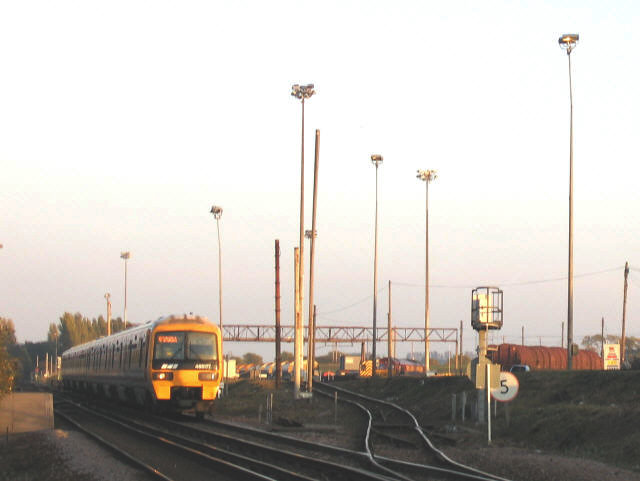|
Denton Halt Railway Station
Denton Halt was a halt between Milton Road Halt and Milton Range Halt on the Hundred of Hoo Railway The Hundred of Hoo Railway is a railway line in Kent, England, following the North Kent Line from Gravesend before diverging at Hoo Junction near Shorne Marshes and continuing in an easterly direction across the Hoo Peninsula, passing near .... It opened in July 1906 and closed on 4 December 1961. The halt was about from Gravesend Central.Southern Railway Halts, p43. The station was demolished after closure and there are no remains today. The level crossing adjacent to the station was closed in 1971 and replaced with a footbridge. References Sources * External links Subterranea Britannica {{Closed stations Kent Disused railway stations in Kent Former South Eastern Railway (UK) stations Railway stations in Great Britain opened in 1906 Railway stations in Great Britain closed in 1961 1906 establishments in England 1961 disestablishments in England ... [...More Info...] [...Related Items...] OR: [Wikipedia] [Google] [Baidu] |
Gravesend, Kent
Gravesend is a town in northwest Kent, England, situated 21 miles (35 km) east-southeast of Charing Cross (central London) on the south bank of the River Thames and opposite Tilbury in Essex. Located in the diocese of Rochester, it is the administrative centre of the Borough of Gravesham. Its geographical situation has given Gravesend strategic importance throughout the maritime and communications history of South East England. A Thames Gateway commuter town, it retains strong links with the River Thames, not least through the Port of London Authority Pilot Station and has witnessed rejuvenation since the advent of High Speed 1 rail services via Gravesend railway station. The station was recently refurbished and now has a new bridge. Toponymy Recorded as Gravesham in the Domesday Book of 1086 when it belonged to Odo, Earl of Kent and Bishop of Bayeux, the half-brother of William the Conqueror, its name probably derives from ''graaf-ham'': the home of the reeve or ... [...More Info...] [...Related Items...] OR: [Wikipedia] [Google] [Baidu] |
Uralite Halt Railway Station
Uralite Halt (TQ 702 737 ) was a halt between Milton Range Halt and Cliffe station on the Hundred of Hoo Railway The Hundred of Hoo Railway is a railway line in Kent, England, following the North Kent Line from Gravesend before diverging at Hoo Junction near Shorne Marshes and continuing in an easterly direction across the Hoo Peninsula, passing near .... Built to serve the British Uralite works, it opened in July 1906 and closed on 4 December 1961.Southern Railway Halts, p57. The halt was demolished soon after closure. References Sources * External links Subterranea Britannica {{Closed stations Kent Disused railway stations in Kent Former South Eastern Railway (UK) stations Railway stations in Great Britain opened in 1906 Railway stations in Great Britain closed in 1961 Transport in Medway ... [...More Info...] [...Related Items...] OR: [Wikipedia] [Google] [Baidu] |
1906 Establishments In England
Nineteen or 19 may refer to: * 19 (number), the natural number following 18 and preceding 20 * one of the years 19 BC, AD 19, 1919, 2019 Films * ''19'' (film), a 2001 Japanese film * ''Nineteen'' (film), a 1987 science fiction film Music * 19 (band), a Japanese pop music duo Albums * ''19'' (Adele album), 2008 * ''19'', a 2003 album by Alsou * ''19'', a 2006 album by Evan Yo * ''19'', a 2018 album by MHD * ''19'', one half of the double album ''63/19'' by Kool A.D. * ''Number Nineteen'', a 1971 album by American jazz pianist Mal Waldron * ''XIX'' (EP), a 2019 EP by 1the9 Songs * "19" (song), a 1985 song by British musician Paul Hardcastle. * "Nineteen", a song by Bad4Good from the 1992 album '' Refugee'' * "Nineteen", a song by Karma to Burn from the 2001 album ''Almost Heathen''. * "Nineteen" (song), a 2007 song by American singer Billy Ray Cyrus. * "Nineteen", a song by Tegan and Sara from the 2007 album '' The Con''. * "XIX" (song), a 2014 song by Slipk ... [...More Info...] [...Related Items...] OR: [Wikipedia] [Google] [Baidu] |
Railway Stations In Great Britain Closed In 1961
Rail transport (also known as train transport) is a means of transport that transfers passengers and goods on wheeled vehicles running on rails, which are incorporated in tracks. In contrast to road transport, where the vehicles run on a prepared flat surface, rail vehicles (rolling stock) are directionally guided by the tracks on which they run. Tracks usually consist of steel rails, installed on sleepers (ties) set in ballast, on which the rolling stock, usually fitted with metal wheels, moves. Other variations are also possible, such as "slab track", in which the rails are fastened to a concrete foundation resting on a prepared subsurface. Rolling stock in a rail transport system generally encounters lower frictional resistance than rubber-tyred road vehicles, so passenger and freight cars (carriages and wagons) can be coupled into longer trains. The operation is carried out by a railway company, providing transport between train stations or freight customer facilit ... [...More Info...] [...Related Items...] OR: [Wikipedia] [Google] [Baidu] |
Railway Stations In Great Britain Opened In 1906
Rail transport (also known as train transport) is a means of transport that transfers passengers and goods on wheeled vehicles running on rails, which are incorporated in tracks. In contrast to road transport, where the vehicles run on a prepared flat surface, rail vehicles (rolling stock) are directionally guided by the tracks on which they run. Tracks usually consist of steel rails, installed on sleepers (ties) set in ballast, on which the rolling stock, usually fitted with metal wheels, moves. Other variations are also possible, such as "slab track", in which the rails are fastened to a concrete foundation resting on a prepared subsurface. Rolling stock in a rail transport system generally encounters lower frictional resistance than rubber-tyred road vehicles, so passenger and freight cars (carriages and wagons) can be coupled into longer trains. The operation is carried out by a railway company, providing transport between train stations or freight customer faciliti ... [...More Info...] [...Related Items...] OR: [Wikipedia] [Google] [Baidu] |
Former South Eastern Railway (UK) Stations
A former is an object, such as a template, gauge or cutting die, which is used to form something such as a boat's hull. Typically, a former gives shape to a structure that may have complex curvature. A former may become an integral part of the finished structure, as in an aircraft fuselage, or it may be removable, being using in the construction process and then discarded or re-used. Aircraft formers Formers are used in the construction of aircraft fuselage, of which a typical fuselage has a series from the nose to the empennage, typically perpendicular to the longitudinal axis of the aircraft. The primary purpose of formers is to establish the shape of the fuselage and reduce the column length of stringers to prevent instability. Formers are typically attached to longerons, which support the skin of the aircraft. The "former-and-longeron" technique (also called stations and stringers) was adopted from boat construction, and was typical of light aircraft built until the ... [...More Info...] [...Related Items...] OR: [Wikipedia] [Google] [Baidu] |
Headington
Headington is an eastern suburb of Oxford, England. It is at the top of Headington Hill overlooking the city in the Thames valley below, and bordering Marston to the north-west, Cowley to the south, and Barton and Risinghurst to the east. The life of the large residential area is centred upon London Road, the main road between London and Oxford. History The site of Headington shows evidence of continued occupation from the Stone Age, as the 2001 field excavations in Barton Lane found, suggesting a date in the 11th century BC. Pottery was found on the Manor Ground, suggesting an Iron Age settlement there in the 7th century BC. Roman kilns from about 300 have been found, including one now on display at the Museum of Oxford. Anglo-Saxon burial remains from about 500 have also been discovered. Headington's toponym is derived from the Old English ''Hedena's dun'', meaning "Hedena's hill", when it was the site of a palace or hunting lodge of the Kings of Mercia. In a charter of 1 ... [...More Info...] [...Related Items...] OR: [Wikipedia] [Google] [Baidu] |
Hoo Junction Staff Halt Railway Station
Hoo Junction is a rail yard on the North Kent Line, near the village of Higham, Kent and North Kent Marshes, Shorne Marshes, operated by English Welsh and Scottish Railway, DB Schenker. It is between Gravesend railway station, Gravesend and Higham railway station, Kent, Higham stations, at the junction with the freight-only Single track (rail), single-track Hundred of Hoo Railway, Hoo branch to the Hoo Peninsula. Layout There are up and down yards on either side of the main line, with the single-track Grain branch line entering from the north east. The up yard (south of the main line) consists of 14 sidings and three through roads, with other ancillary sidings. The down yard (north of the main line) consists of 10 sidings and three through roads. Some sidings in the down yard have been taken up. As part of Phase 1 of the Kent Coast Electrification Scheme, the yard at Hoo Junction had a simple overhead catenary system installed in 1959, to accommodate the Class 71 electric loco ... [...More Info...] [...Related Items...] OR: [Wikipedia] [Google] [Baidu] |
Gravesend Railway Station
Gravesend railway station serves the town of Gravesend in north Kent, England. It is down the line from . Train services are operated by Southeastern and Thameslink. During Christmas 2013, a major overhaul of the lines and platforms changed the four track, two platform layout into two through lines and a western facing bay platform. History The first railway line to arrive in Gravesend was the ''Gravesend & Rochester Railway'' (G&RR) who had purchased the Thames and Medway Canal and its tunnel between Strood and Higham. The G&RR ran the first train to the then terminus at Gravesend (adjacent to the Canal Basin) on 10 February 1845. On 30 July 1849 the line was extended to ''North Kent East Junction'' on the South Eastern Railway (SER) and thence to London Bridge. There was a second Gravesend station (later known as Gravesend West Street then later still Gravesend West) opened by SER's rivals, London, Chatham & Dover Railway (LCDR). It was the end of a branch off the ... [...More Info...] [...Related Items...] OR: [Wikipedia] [Google] [Baidu] |
Gravesham
Gravesham ( ) is a local government district with borough status in north-west Kent, England. Its administrative centre and largest town is Gravesend, which was known as ''Gravesham'' in ancient times. Gravesham was formed on 1 April 1974 by the merger of the Municipal Borough of Gravesend with Northfleet Urban District and part of Strood Rural District, under the Local Government Act 1972. It borders the Borough of Dartford and Sevenoaks District to the west, the Borough of Tonbridge and Malling to the south, the Medway unitary authority to the east and the Thurrock unitary authority of Essex to the north, via the River Thames. Gravesham is twinned with Cambrai in Hauts-de-France, France. The present borders of Gravesham parliamentary constituency are almost the same as those of the borough. History Robert Heath Hiscock LL.B., F.S.A., Chairman of the Gravesend Historical Society, in the foreword to his book, 'A History of Gravesend' (Phillimore, 1976) wrote: :"The name G ... [...More Info...] [...Related Items...] OR: [Wikipedia] [Google] [Baidu] |
Hundred Of Hoo Railway
The Hundred of Hoo Railway is a railway line in Kent, England, following the North Kent Line from Gravesend before diverging at Hoo Junction near Shorne Marshes and continuing in an easterly direction across the Hoo Peninsula, passing near the villages of Cooling, High Halstow, Cliffe and Stoke before reaching the Isle of Grain and the container port on its eastern tip, Thamesport. There used to be a short branch line leading from Stoke Junction to the coastal town of Allhallows but this closed from 4 December 1961, the same date on which the Hundred of Hoo line was closed to passenger services. Early history Authorisation The first authorisation to construct a railway on the Hoo Peninsula was obtained by a group of local businessmen who sponsored the passing of the North Kent Extension Railway Act in 1865 which provided for the construction of a branch line leaving the South Eastern Railway's Gravesend - Strood line at Denton. The line would head eastwards across ... [...More Info...] [...Related Items...] OR: [Wikipedia] [Google] [Baidu] |





